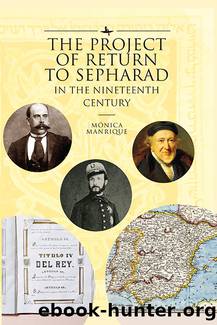The Project of Return to Sepharad in the Nineteenth Century by MONICA MANRIQUE

Author:MONICA MANRIQUE
Language: eng
Format: epub
Publisher: Academic Studies Press
Published: 2020-08-15T00:00:00+00:00
10. A NEW ATTEMPT BY GUEDALLA IN 1881
The desire to put an end to the continuous and progressive disorder unleashed by the revolution of 1868, the need to resolve a situation with General Serrano at the head of the State, judged to be interim and unstable, the sympathy aroused by the young king; and, above all, the clever, patient and pragmatic policies of Cánovas del Castillo gave rise to the Constitution of 1876, thus establishing the Restoration, conciliating wills and mitigating mistrust.85
As for the religious question, we must say that there was somewhat of a step backwards, as the new Constitution was more conservative than that of 1868. Nevertheless, it continued to allow a certain measure of tolerance.
In that same year the Board of Deputies of London sent a new appeal, this time to Alfonso XII, calling once more for the revocation of the expulsion edict.86
Between 1876 and 1877 several books were published on the Jews and on intolerance in the history of Spain, such as that by Amador de los RÃos, History of the Jews; Valeraâs speech of 1876 at the Royal Academy; Gloria, by Galdós; and Castelarâs defence of the Sephardim in Memories of Italy, favourable to Jews and the freedom of religion.87
In February of 1881 Sagastaâs Liberal party rose to power. The situation of Sephardi communities in different parts of Europe was worsening at the time, with violent waves of anti-Semitism particularly affecting the Jews in the Balkan countries, Eastern Europe, and Russia.
Spanish diplomats began to report on this terrible situation, and soon after Alfonso XII and the Sagasta government decided to adopt some measures to ameliorate it, or at least repatriate Jews from those areas. These measures gave rise to a real interest in the Jews amongst the Spanish authorities. This policy of relocation was included in the general lines of Sagastaâs foreign policy, as this order was transmitted to all the delegations where the Jewish problem existed.88
As Isidro González points out, the decision by Alfonso XII and his government to offer asylum to Jews persecuted by Russia and the Balkan countries had an international impact, ranging from its rejection by some German newspapers, to enthusiastic reactions, such as that by some media and organizations in Great Britain, where this measure aroused sympathy towards Alfonso XII and the governmentâs policy.89
We must add that this reaction of sympathy shown by the English press was not a ânewâ one, nor was the letter that Guedalla sent to Sagastaâs government.
We have seen how the Jewish press, both English, through the Jewish Chronicle; and French, through the Archives Israélites and lâUnivers Israélite, supported the new provisional government of 1868, as well as its main figures, particularly Emilio Castelar, who was repeatedly praised in the Jewish press. Guedalla must have been astonished to find that the Sagasta government paid such attention to a problem that he had tried to âput rightâ after La Gloriosa (we should recall that Guedallaâs main objective was to promote and foment immigration by the Sephardim to Spain in 1868â1869).
Download
This site does not store any files on its server. We only index and link to content provided by other sites. Please contact the content providers to delete copyright contents if any and email us, we'll remove relevant links or contents immediately.
Getting It, Then Getting Along by L. Reynolds Andiric(629)
Religion and Politics Beyond the Culture Wars : New Directions in a Divided America by Darren Dochuk(446)
Global Justice, Christology and Christian Ethics by Lisa Sowle Cahill(409)
Positive Psychology in Christian Perspective: Foundations, Concepts, and Applications by Charles Hackney(341)
Forgiveness and Christian Ethics by Unknown(327)
Douglas Hamp The First Six Days by Unknown(256)
The Horrors and Absurdities of Religion by Arthur Schopenhauer(241)
Insurgency, Counter-insurgency and Policing in Centre-West Mexico, 1926-1929 by Mark Lawrence(234)
Christian Martyrdom and Christian Violence by Matthew D. Lundberg;(223)
The Oxford Handbook of Greek and Roman Mythography by R. Scott Smith;Stephen M. Trzaskoma;(217)
Beyond Heaven and Earth by Gabriel Levy(210)
God and Eros by Patterson Colin;Sweeney Conor;(207)
The Bloomsbury Reader in Christian-Muslim Relations, 600-1500 by David Thomas;(205)
Autobiography, Volume 2: 1937-1960, Exile's Odyssey by Mircea Eliade(195)
Witches: the history of a persecution by Nigel Cawthorne(192)
Cult Trip by Anke Richter(192)
An Introduction to Kierkegaard by Peter Vardy(178)
The Global Repositioning of Japanese Religions by Ugo Dessi(172)
The Believer by Sarah Krasnostein(171)
